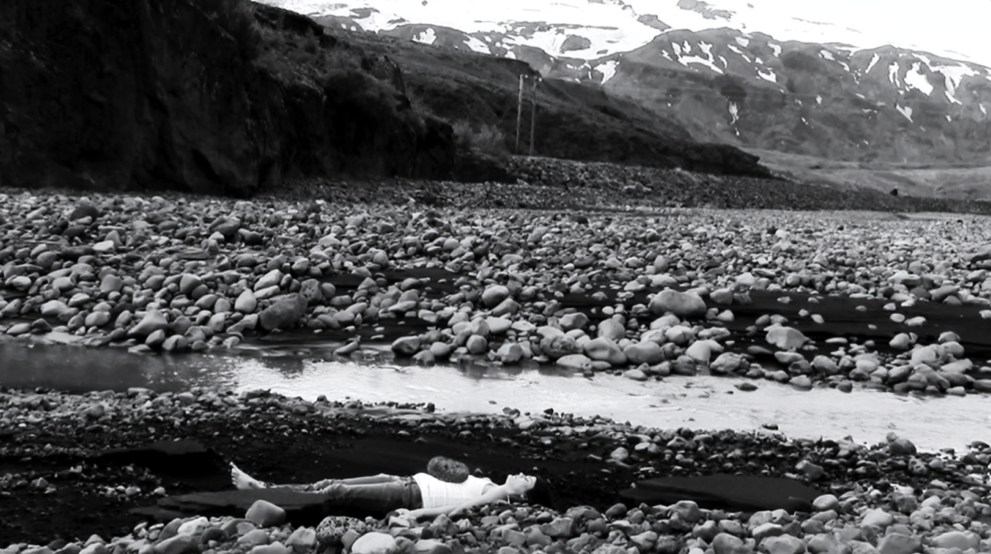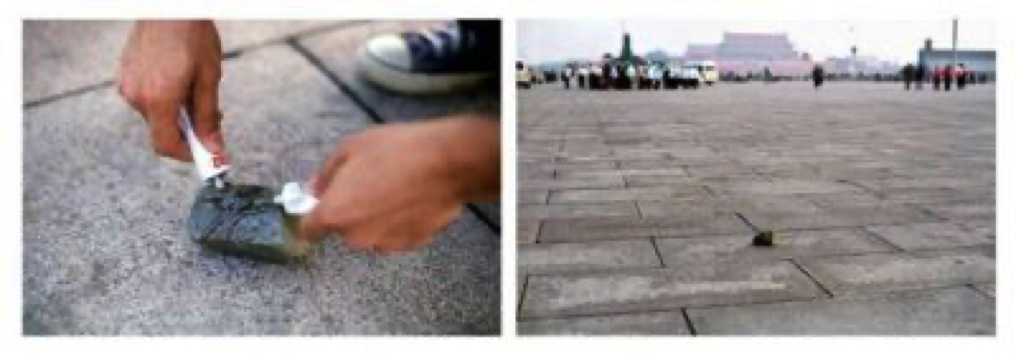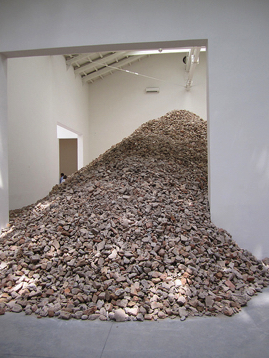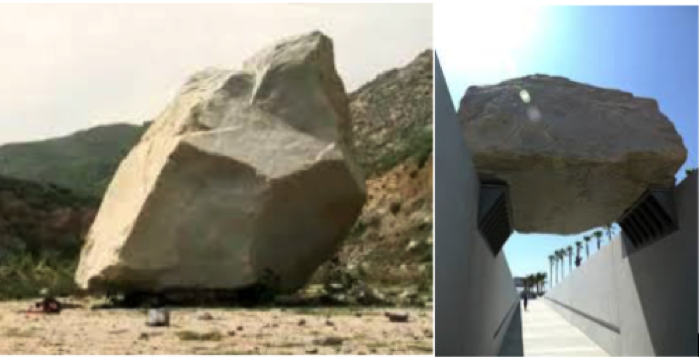The Living Stone
In my past works, the stone was the building block object in the process of understanding my gender and immigrant identities. I have used the stone as the cyclical movement of life and death, rituals of passage, memory, and cultural preservation. Today I am interested in stripping the material from metaphorical meanings. My last work took place at the volcano canyon of Eyjafjallajökull in Iceland, which after high seismic activity, in spring 2010, erupted and left most of the area of Thórsmörk in southern Iceland covered by ashes. In my performance, I held a volcanic igneous rock formed from cooling and solidification of magma and fractional crystallization. I was interested in the affirmation that the body is just as mineral as that object existing for the first time in a land transformed by a natural disaster.
The Living Stone | Simone Couto | Eyjafjallajökull | 2015
Recently, the stone has become a symbol of political resistance. For the Chinese artist Zhao Zhao, who worked for seven years as Ai Weiwei’s assistant and follows many of his mentor’s steps, the stone is an instrument of protest. In the photograph Cobblestone (2007) the documentation of his performance, Zhao glued his minuscule stone on the ground of Tiananmen Square in China to express the contemporary world’s tensions between freedom and control such as violation of human rights, racial or sexual discrimination, and wars. Zooming our critical lenses, Zhao specifically protests against China and the government’s contract to brutally restrict the right to freedom.

In both New and Old Testament texts, the constant reference to the stone is an easy-to-assimilate metaphor, used to educate the illiterate during preaching, a bridge-symbol from religious concept to practice. In Isa 51:1-2, the Hebrew word sûr (rock), contains the metaphor of a quarry. God says, “‘listen to me, you who pursue righteousness and who seek the Lord: Look to the rock from which you were cut and to the quarry from which you were hewn. One of the most salient features of the stone symbolism is that it is used to refer and describe the existence of God such as in Ps 42:9 “I say to God my Rock (sal’ î), "Why have you forgotten me? Why must I go about mourning, oppressed by the enemy?” In the New Testament we are urged to embrace the stone as the foundation of that faith: “you also, like living stones, are being built into a spiritual house.”
In the beginning of last century, the stone was dressed with new metaphors deeply connected to our human experiences. For the Brazilian poet Carlos Drummond de Andrade, the stone is that difficulty in the middle of the way that makes us slow down and rethink our place in the world. It is the small object that, yet ephemeral and recurrent, will change the course of our histories. “In the middle of the road there was a stone/there was a stone in the middle of the road/ there was a stone/ in the middle of the road there was a stone. /Never should I forget this event/ in the life of my fatigued retinas”, writes the poet. In the middle of the road, there was a stone (1924), considered a weak one back then due to the repetitiveness of the main verse when it was first published, today it is certainty one of Drummond’s most respected and well-known work. The repetition of these verses Can be thought as the recurrent journey of Sisyphus and his stone, both eternally trapped into the physical laws of this planet and the rage of the gods.
In Education by the Stone, written in 1928, the poet João Cabral de Melo Neto liberates the stone from any possible symbolism. He opts for the hard objective reality, hiding any open and sentimental significance. In the following two verses, “In the backlands the stone does not give lessons, / And if it gave them, nothing would be taught; ” the realities that informed his building materials were the arid lands of his native northeastern Brazil where its inhabitants don’t have the means to romanticize life. The poet constructed his poems as an architect. The stone is just a stone as the hardship of living is nothing else but what it is: emotionally removed from context, without giving subjective reflection or apparent compassion.
In If you hold a stone, Caetano Veloso, the acclaimed Brazilian musician and writer, projects the weight of our human condition and our capacity for change into the stone he urges us to hold in the center of our hands. Veloso recorded his self-titled album in England when the artist was in an exile imposed by the Brazilian government of the time for being subversive. The song was written in 1971 and was dedicated to the visual artist Lygia Clark in the context of meeting her in Europe and becoming more exposed to her art. The lyrics clearly reveals the necessity of a kind of trans-formative art: “If you hold a stone, hold in your hand/ If you feel the weight/ You’ll never be late/ To understand… Mas eu não sou daqui/ Marinheiro só/ Eu não tenho amor.” The “if you” transfers the first person in the speech to effectively evoke the second person: the other. The transformation of the human experience does not happen in isolation but with the other and through the exercise of empathy, acknowledgment of loneliness and the pain itself, all contained in his experience as foreigner and a man in exile. The only possible verses to be sung in Portuguese comes from a Brazilian folk song that says “ I am not from here/ I am a lonely sailor/ I do not have love in me.”

Cobblestone | Zhao Zhao | 2007
Moving away from metaphorisms, the Spanish artist and historian Laura F. Gibellini explores the human experience in relationship to the earth-itself and its natural phenomenon. They are indicatives for human dwelling and cultural formation. Her practice and thinking combined comprise the natural conditions that allow life to exist and develop, as she writes in her paper Approximations to a Working Space for the Intar Journal Vol. 06, produced by the Rhode Island School of Design. The paper focuses on oceanic and atmospheric shifts, however the implication is that Gibellini is aware that geology is the foundational platform.
Thinking of the presence of the stone as a geological object in-transition and a building block for the discourse of place and territorialization, I refer to the ideas of Deleuze and Guattari in 1000 Plateaus: Capitalism and Schizophrenia. Stratification is the process of creating hierarchical bodies while territorialization is the ordering of those bodies in “assemblages,” an emergent and consistent unity joining heterogeneous bodies. The material is removed from its original function so new ones can be established as a process of re-beginning.
Since the mid-1990s, the practice of the Spanish artist Lara Almarcegui deals with peripheral urban wastelands, demolitions, vacant urban spaces, urban planning and modern ruins. Engaged with space, she uses local and archival materials, video and photography to build up her installations. For the Spanish Pavilion at the 55th Biennale di Venezia exhibition, Almarcegui filled multiple rooms with several piles of pulverized construction materials—cement rubble, gravels of varying diameters, pebbles, dirt, and glass to get the message across.

Lara Almarcegui | 55th international art exhibition | 2013
In 2012, Michael Heizer, the contemporary artist specialized in large-scale sculptures and Land Art, installed a 340-ton boulder affixed above a concrete trench through which visitors may walk in the Los Angeles County Museum’s (LACMA). The massive stone, the work itself called Levitated Mass (can we still talk about ephemera in here when we think of scale?), traveled nearly two-week journey from Stone Valley Quarry in Jurupa Valley (Riverside County, California). Heizer stripped his work from the public explanation of the meaning or significance of this particular work.
More than discussing my work in relationship to the object—the stone, or/and its poetic uses and projections, I am interested in investigating the multiple meanings embedded in its historicity. In this paper I have pulled examples from poetry, visual arts and philosophy to rebuild a fragment of the journey of the stone in the arts. I am drawn to the idea that this historicity arrives at a point where a stone can also be considered a de-contextualized object, one challenging a conventional chronology; it can be removed from human presence and exist on its own.

Levitated Mass | Michael Heizer | 2012